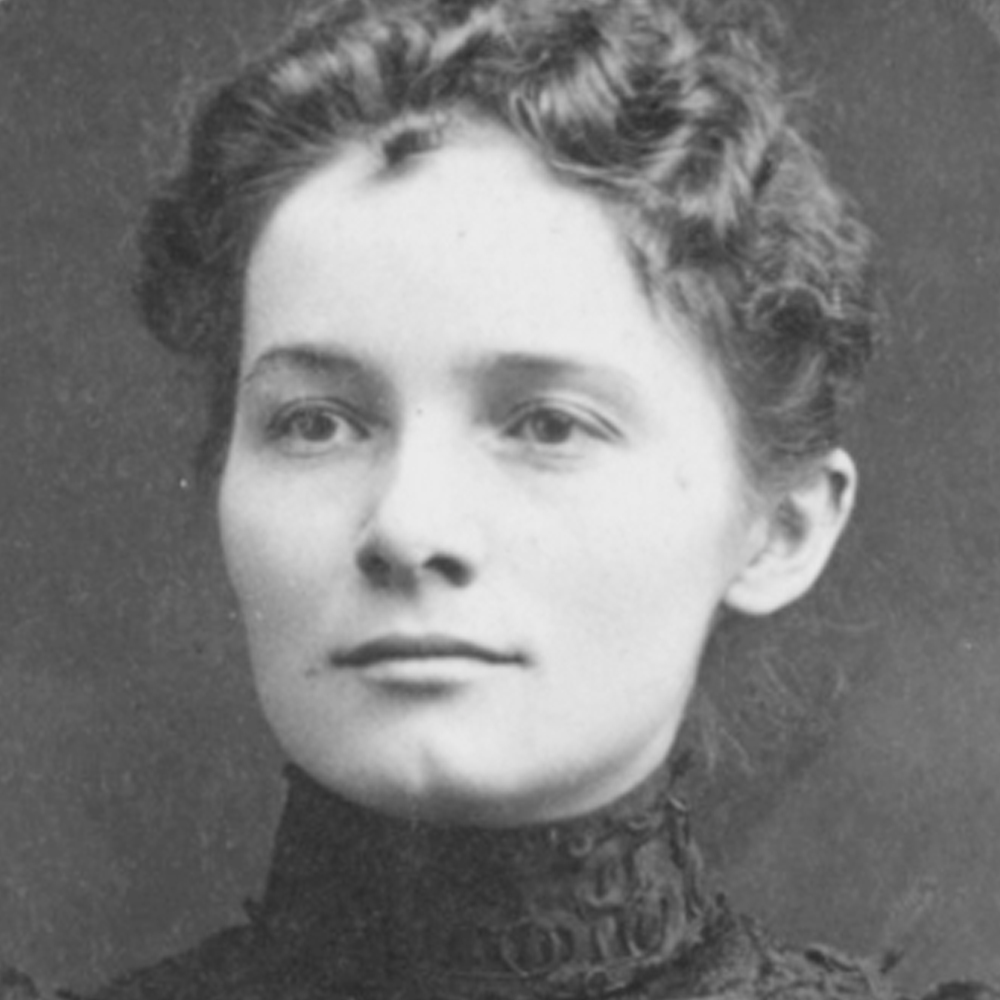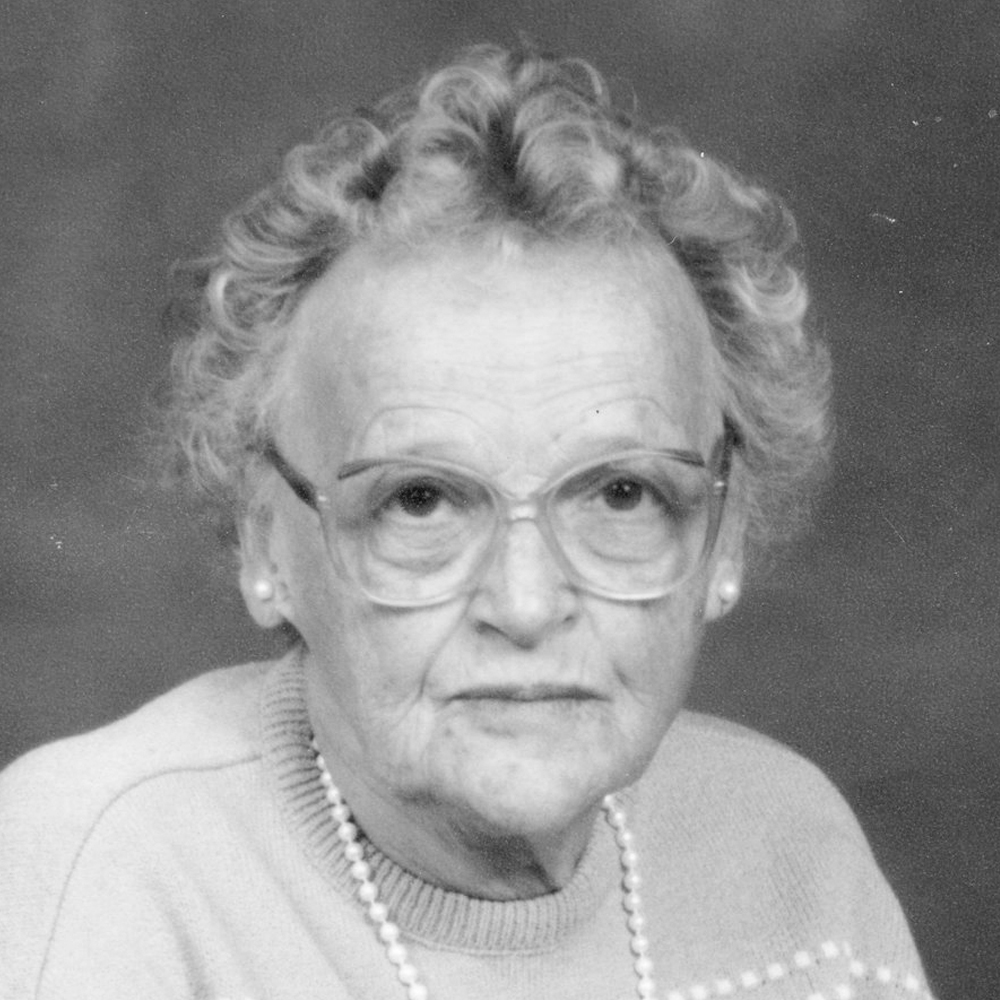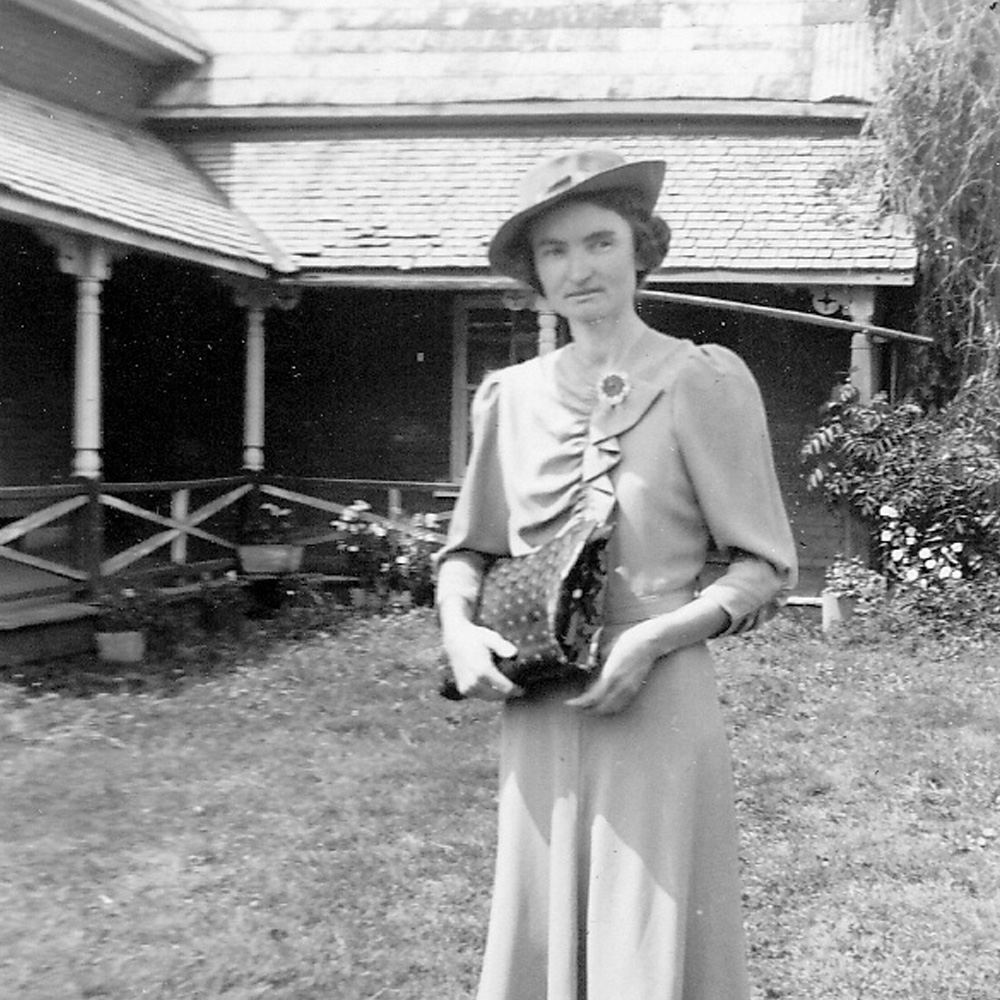NOTABLE WOMENT OF THE GATINEAU VALLEY
This virtual exhibit celebrates four remarkable women of the Gatineau Valley
Spanning the years 1816 – 2008, the lives of these women differed greatly in many respects, but what they all have in common is the setting of the region. Against this dynamic landscape, which is in turns beautiful and forbidding, inspiring and harsh, they contributed their formidable reserves of energy, their talent, and what little spare time they had to improving the world around them. Through her life’s work, each woman in this exhibition altered the physical and social landscape of our area in ways that continue to shape our lives.
Ghislaine Sincennes was a busy farmer, mother of five, craftswoman, and volunteer, but she always made room in her life for more—more people at her kitchen table and more community causes to support.
During the summer, you could always find her on her International tractor, raking hay in the fields with her husband, Gérard. Spring would find her at the couple’s sugar shack, la Sucrerie Sincennes. Following a request to allow school children to visit, the Sincennes opened the sugar shack to the public, who delighted in learning about the process of producing some of Quebec’s most famous maple syrup. At both the farm and the sugar shack, Ghislaine and Gérard were wonderful hosts. Over the years, they welcomed countless young people from the Katimavik program, who loved being on their farm so much they sometimes chose to live there instead of returning to the group accommodations at Camp Gatineau. During the summer, Ghislaine often cooked for over a dozen people, including family, friends, neighbours, and Katimavik participants, who kept in close touch long after their stay on the farm was over.
When her husband’s illness prompted a move from the farm to the village, Ghislaine threw herself into work at her church, the Paroisse Ste-Cécile de Masham, where she sang in the church choir and helped organize the church’s 150th anniversary celebrations. She participated on countless committees, including the Cercle des fermières du Quebec, where she worked at the local and provincial levels. She was also a talented craftswomen, particularly skilled at knitting and quilting. An active member of the parents’ school committee, she was instrumental in lobbying to establish Masham’s high school, École secondaire des Lacs. In 2001, during the International Year of Volunteers, she was honoured as Volunteer of the Year for La Pêche.
[PHOTO: COURTESY OF ANDRÉ SINCENNES]
Catherine, known as Ketty, was born in County Mayo, Ireland, to tenant farmers. She experienced the horrors of the Great Irish Hunger of 1847 and the death of a husband and two children before immigrating to Canada. She embarked on the perilous Atlantic crossing with her sister, brother-in-law, and their children. One by one, the family died, and Catherine, always a religious woman, bribed the sailors with biscuits to ensure they were allowed a small wake before being thrown into the sea. After making her way to Kingston, where she was quarantined, she joined a group of people walking the nearly 200 kilometres to Bytown (Ottawa), where she found work as a maid.
Through friends in Cantley, Catherine met and married another Irish immigrant, William Holmes. Thus began the second phase of Catherine’s life as a busy farm wife and mother of nine on an isolated farm in Wilson’s Corners. She worked the land, raised a large family, smoked a clay pipe, and never missed saying the rosary at night. Her faith saw her tramping through the bush with her two-week-old daughter, ferrying across the Gatineau River, and continuing the journey to St. Stephen’s Church in Chelsea on foot to have her baby baptized.
Catherine and William worked their piece of farm land for 14 years before receiving their land grant, and the farm has remained in the family ever since. Although Catherine received letters from Ireland, she never returned to her homeland.
To view video of Catherine’s life click HERE
[PHOTO: COURTESY OF AGATHA HOLMES DALY]
Alice Cross Wilson led a busy life, as lively as the powerful set of rapids beside which she made her home.
Alice and her husband, Samuel Wilson, ran the Peerless Hotel, a four-story, 30-room brick hotel at the heart of the community of Cascades. In addition to guests, which included workers from the log drive and the Chelsea dam, the hotel housed the town’s post office, telephone exchange, and general store. It was also home to Alice’s ten children, her mother, and her grandfather, who lived to be 104.
In addition to the task of raising a large family, running a hotel, and hosting a variety of social activities, including fundraising events during the First World War, Alice played organ at Anglican and United services for over forty years. Her children remember her practicing hymns at night, after she had put them to bed, the music wafting up through a stove-pipe hole in the large dining-room ceiling. One of their favourites was “Shall we gather at the river, the beautiful, beautiful river,” which they always assumed was about their beautiful Gatineau River and the unusual, bustling home their mother had built for them, and many others, there.
Female writers were not commonplace at the turn of the century, and young girls had even fewer opportunities to have their voices heard. And yet, at the age of fourteen, Ada Almira Brown became the valley correspondent for the Ottawa Evening Citizen.
Ada was the third generation to work the land on her family’s Cantley farm. Well versed in farm life, she was also a prize-winning student at Cantley’s one-room school, where, after completing the curriculum, she spent her final year studying the dictionary.
For several years between 1895 and 1907, Ada was paid for her writings with a subscription to the Citizen, a pad of yellow paper on which she wrote her notes, and an honorarium of $30 a year. She wrote in a cheerful, down-to-earth manner about country life, informing her readers of the climate and soil of Quebec, the seasons (spring being her favourite), and the types of crops sown and animals raised on local farms. She also offered her observations on the larger world, giving us a glimpse of Ottawa as a booming capital of 40,000 with policemen constantly patrolling the streets to keep order.
In 1905, Ada married Charles Howard Reid of Kirk’s Ferry, where she spent the rest of her life as a busy farm wife and mother of five children. Her descendants still live in Chelsea.
[PHOTO: GVHS 00834]
Alice Powers came to Cantley as a teacher in 1924. After marrying Maynard McGlashan in 1925, she devoted herself to raising a family and running the McGlashan General Store at Wilson’s Corner. At the heart of the community, the two-story wooden building was home to a general store, post office, and the McGlashan family residence.
Alice had her hands full raising a family and running a business with none of the modern conveniences we rely on today. The store, for example, did not receive electricity until 1948. Then, on a dark morning in late January of 1938, her strength was truly tested. At 5:00 a.m. while snow was falling, the roads were blocked solid, and Alice’s husband and two-year-old son, both very ill, were staying with family in Ottawa, the building caught fire. Despite the community’s best efforts with a bucket brigade, it burnt to the ground. Everything was lost.
Alice took her eight-year-old son across the road to stay at Mrs. Lawlis’s boarding house, where a broken window pane allowed snow in onto the bed as they slept. Within days of the fire, Alice had set up a temporary general store and post office in the boarding house living room. Soon, she moved the operation to a small house on the store property, where she carried on until a new store was built. There was barely a pause in service as, supported by her neighbours, Alice showed tremendous strength and determination in the face of a disaster that could easily have robbed Wilson’s Corner of an important community hub.
Video: In January 1938, a devastative fire destroyed the McGlashan General Store in Wilson’s Corner. Alice sets out to reopen a temporary store in a neighbour’s home. To view video of Alice’s life click HERE
[PHOTO: COURTESY OF PETER McGLASHAN]
By the time Hazel Stearns graduated from high school, she knew she wanted to be a teacher. While teaching in a one-room school in the Pontiac, she met another female teacher who offered her a job at Barriere Lake, an Algonquin reserve north of Maniwaki. Hazel agreed, and the two women, Hazel still a teenager, set out on an extraordinary commute.
In early May, they took a train from Hull to Maniwaki, the end of the line. There, they were met by a teamster with his horses and wagon, and they began a three-day journey to Bark Lake Depot, a stopover on the shores of Barriere Lake. They rode in the wagon when they could, but they often had to walk because the spring terrain was too rough, with mud reaching the wheel axles. When they finally reached Barriere Lake they boarded canoes with outboard motors and were taken 50 miles up the lake to a small cottage, their home for the summer. They taught English to the Algonquin community who had pitched their summer tents near the Catholic Church and Hudson’s Bay Store. In September, with the first frost, they went home. They returned to the lake the following summer, this time, thanks to a friend’s connections with the Quebec Forest Fires Association, in a sea plane. Hazel eventually graduated from Macdonald College with a teaching degree and taught at Lascelles School and Wakefield School. She married Carl Gibson, a native of Rupert, and lived in the Gatineau Hills until the death of her husband.
Video: Hazel reminisces about there younger days as a young school teacher and the trip to reach Barrier Lake.To view video of Hazel’s life click HERE.
[PHOTO:COURTESY OF WILMA CHARLEBOIS]
Eirene McClelland was a trailblazer. In addition to her role as farm wife and mother, she made tremendous contributions to her community through her work for the local Protestant school board, St. Andrew’s United Church, and as a writer preserving local history.
In 1941, shortly after Eirene married Trevellyn McClelland, he became secretary treasurer of the local Protestant school board. Stationed behind her Underwood typewriter, Eirene did most of the day-to-day paperwork. She was involved in some major changes to education in Cantley, such as the closing of its one-room schoolhouse, which struggled to find qualified teachers and often did not see students continuing past the seventh grade. Following a series of hurdles, including widening a side road to permit the new school bus to negotiate a tight corner, Cantley students were literally on the road to better education in Hull. Soon, other schools in the region followed suite, and the Western Quebec School Board was created.
School board work was not the only writing Eirene did on her Underwood. She was also the Cantley contributor to the Ottawa Citizen and, an authority on local history, a pillar in her church, and a dedicated church organist for over 30 years, she set out to write a history of St. Andrew’s for its centennial. The scope of the document grew with her research, and she ended up creating the first detailed history of Cantley, St. Andrew’s United Church, and the local Protestant schools.
To view video of Eirene’s life click HERE
[PHOTO: COURTESY OF BOB McCLELLAND]
Jessie Hyde grew up on a farm nestled in the Meech Creek Valley, which she loved for its quiet, secluded atmosphere. She was an exceptionally devout woman who felt the “Call of the Lord” to a life of service. Following training at Bible colleges in Winnipeg and Regina, she served in Home Missions in Western Canada. When her mother fell ill in 1949, she returned to the Gatineau Valley, where she spearheaded the momentous task of establishing a foster home for children and, following its success, a home for seniors.
In a time before social services, Jessie saw a need and set to work addressing it. She formed a dedicated team to help her fulfill her vision of a safe haven for children in her beloved Meech Creek Valley. Jessie’s team included Lloyd Waterston, whom she married in 1954, a year after the home opened. Over the years, as Jessie ran Brookdale Farm Home, she was also at work securing funds for a new building that would allow her to increase the number of children from 12 to 45. The new home was completed in 1960, the same year she opened Morningside Homes, a residence for seniors, situated across the road from Brookdale. Both homes closed in the mid-seventies after all the farms in the Meech Creek Valley were expropriated by the Quebec government. Many of the children who were raised at Brookdale still live in the Gatineau Valley.
Video: Jessie is presenting her proposal to expand Brookdale Farm home for foster children to a group of government officials. To view video of Jessie’s life click HERE
[PHOTO: GVHS 02451-052]
Of all the contributions Norma Walmsley made in her eventful life, the Wakefield Covered Bridge is the most visually striking reminder of her tremendous impact on the Gatineau Valley. When the original 1915 covered bridge was destroyed by fire in 1984, Norma’s reaction was, “Let’s get to work.” She rallied the community and worked tirelessly for ten years until this cherished landmark on the Gatineau River was back in place.
Norma was also involved in numerous other community projects, including the Gatineau Valley Historical Society, the Church of the Good Shepherd, and the Gatineau Memorial Hospital Foundation. A Second World War veteran from service in the Royal Canadian Air Force Women’s Division (WD), where she was Senior Officer in charge of supplies for its personnel in Canada and overseas, she was an active board member of the Wakefield branch of the Royal Canadian Legion, and she helped restore the Wakefield Cenotaph with its new war memorial gardens in the village’s Peace Park.
While Norma was a leading light in her local community, she was also serving on numerous national and international organizations relating to international development and social justice. Too numerous to mention, her accomplishments have been recognized with the Order of Canada, honorary doctorates from Carleton and Brandon Universities, and a Governor General’s Award in Commemoration of the Persons Case for outstanding contributions to the goal of equality for women and girls in Canada.
Video: The Woman Who Lost Her View. When arsonists destroyed the 1915 Gendron Bridge in Wakefield, Norma rallies the community to rebuild the cherished covered bridge. To view video click HERE
[PHOTO: HELENE ANNE FORTIN]
Nicole Bruinsma was a mother, a popular family physician, and a grassroots community activist. When she was diagnosed with breast cancer at the age of 38, with no known risk factors, she embarked on a fact-finding mission about the environmental causes of human illness. What she discovered led her to speak out about the alarming effects of pesticide use.
Nicole founded Action Chelsea for Respect of the Environment (ACRE), a grassroots organization dedicated to promoting and protecting the ecological integrity of Chelsea. Led by ACRE, Chelsea became one of the country’s first municipalities to ban the cosmetic use of pesticides, putting the health of their citizens over the appearance of their lawns. Nicole also inspired change on a larger scale. She appeared before the House of Commons Standing Committee on the Environment and Sustainable Development, encouraging them to recommend a ban on the cosmetic use of pesticides, which they did, and several cities across Canada followed Chelsea’s example.
While struggling with her own health, Nicole fought for the health of her village and her environment. When she died in 2002, she left a legacy of protective environmental legislation that has spread throughout communities across Canada.
Video: Precautionary Principale: The Nicole Bruinsma Story trailer. To view video click HERE
[PHOTO: COURTESY OF SCOTT FINDLAY]










